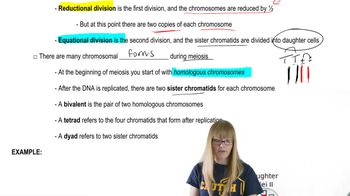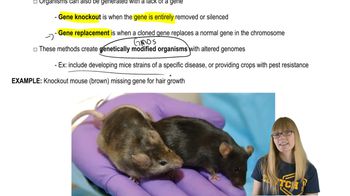What are DNA microarrays? How are they used?
Table of contents
- 1. Introduction to Genetics51m
- 2. Mendel's Laws of Inheritance3h 37m
- 3. Extensions to Mendelian Inheritance2h 41m
- 4. Genetic Mapping and Linkage2h 28m
- 5. Genetics of Bacteria and Viruses1h 21m
- 6. Chromosomal Variation1h 48m
- 7. DNA and Chromosome Structure56m
- 8. DNA Replication1h 10m
- 9. Mitosis and Meiosis1h 34m
- 10. Transcription1h 0m
- 11. Translation58m
- 12. Gene Regulation in Prokaryotes1h 19m
- 13. Gene Regulation in Eukaryotes44m
- 14. Genetic Control of Development44m
- 15. Genomes and Genomics1h 50m
- 16. Transposable Elements47m
- 17. Mutation, Repair, and Recombination1h 6m
- 18. Molecular Genetic Tools19m
- 19. Cancer Genetics29m
- 20. Quantitative Genetics1h 26m
- 21. Population Genetics50m
- 22. Evolutionary Genetics29m
15. Genomes and Genomics
Functional Genomics
Problem 20
Textbook Question
How would you design a genetic screen to find genes involved in meiosis?
 Verified step by step guidance
Verified step by step guidance1
Define the objective of the genetic screen: The goal is to identify genes that are specifically involved in the process of meiosis. Meiosis is a specialized type of cell division that reduces the chromosome number by half, producing gametes or spores. Understanding this process requires isolating mutants that exhibit defects in meiosis.
Choose the model organism: Select an organism that is well-suited for genetic studies, such as yeast (e.g., *Saccharomyces cerevisiae*), fruit flies (*Drosophila melanogaster*), or mice. The choice depends on the experimental tools available and the relevance of the organism to the study of meiosis.
Generate mutants: Use a mutagen (e.g., chemical mutagens like EMS, radiation, or transposon insertion) to induce random mutations in the genome of the model organism. This creates a population of individuals with diverse genetic alterations.
Screen for meiotic defects: Develop a screening method to identify mutants with defects in meiosis. For example, in yeast, you could look for mutants that fail to produce viable spores. In other organisms, you might examine gamete production, chromosome segregation, or fertility as indicators of meiotic function.
Map and identify the mutated genes: Once mutants with meiotic defects are isolated, use genetic mapping, whole-genome sequencing, or complementation tests to identify the specific genes that are disrupted. These genes are candidates for being involved in meiosis.
 Verified video answer for a similar problem:
Verified video answer for a similar problem:This video solution was recommended by our tutors as helpful for the problem above
Video duration:
3mPlay a video:
Was this helpful?
Key Concepts
Here are the essential concepts you must grasp in order to answer the question correctly.
Meiosis
Meiosis is a specialized form of cell division that reduces the chromosome number by half, resulting in the formation of gametes (sperm and eggs). It consists of two sequential divisions: meiosis I and meiosis II, which include processes such as homologous recombination and independent assortment. Understanding meiosis is crucial for identifying genes that regulate this process and contribute to genetic diversity.
Recommended video:
Guided course

Meiosis Overview
Genetic Screening
Genetic screening is a method used to identify and analyze specific genes or mutations associated with particular traits or biological processes. In the context of meiosis, a genetic screen could involve mutagenesis or RNA interference to disrupt gene function, followed by phenotypic analysis to observe effects on meiotic progression. This approach helps pinpoint genes that are essential for successful meiosis.
Recommended video:
Guided course

Descriptive Genetics
Model Organisms
Model organisms, such as yeast, fruit flies, and mice, are widely used in genetic research due to their well-characterized genomes and ease of manipulation. They provide valuable insights into genetic functions and processes, including meiosis. By designing genetic screens in these organisms, researchers can uncover conserved genes and pathways that are critical for meiotic function across species.
Recommended video:
Guided course

Transgenic Organisms and Gene Therapy
Related Videos
Related Practice
Textbook Question
912
views


